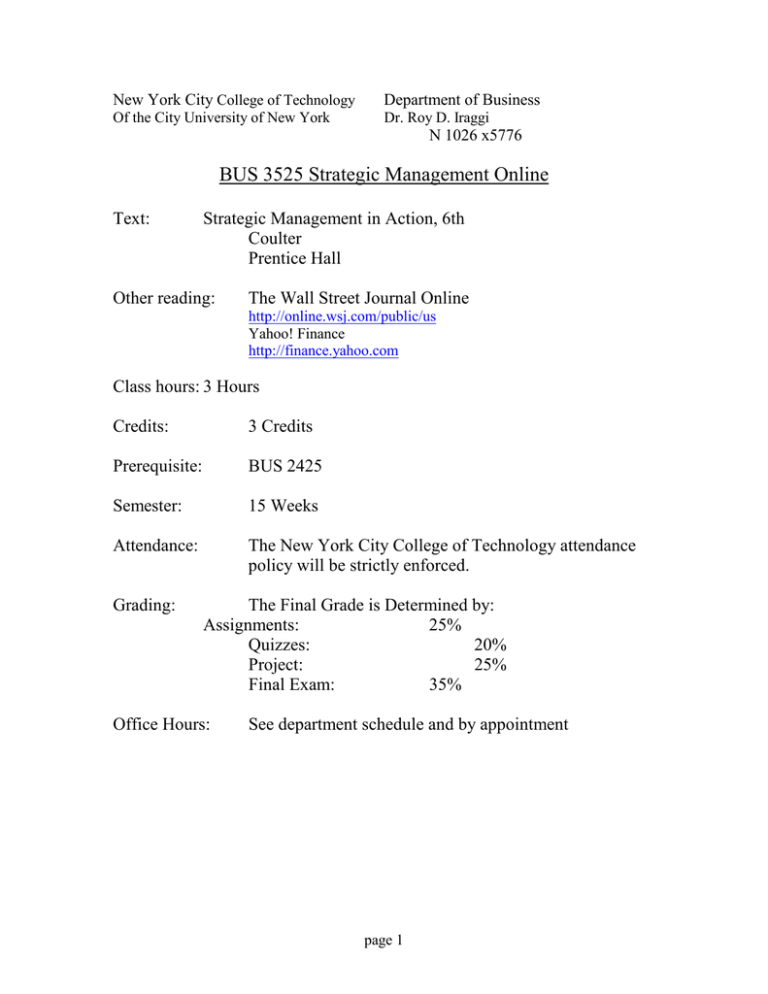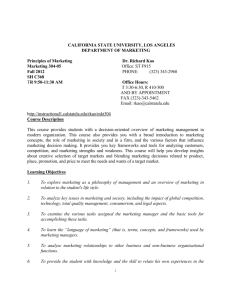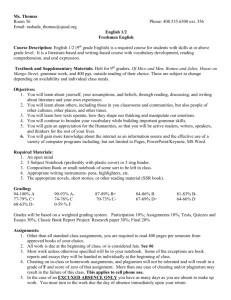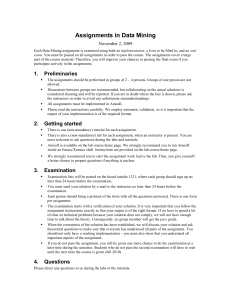BUS 3525 Strategic Management Online
advertisement

New York City College of Technology Department of Business Of the City University of New York Dr. Roy D. Iraggi N 1026 x5776 BUS 3525 Strategic Management Online Text: Strategic Management in Action, 6th Coulter Prentice Hall Other reading: The Wall Street Journal Online http://online.wsj.com/public/us Yahoo! Finance http://finance.yahoo.com Class hours: 3 Hours Credits: 3 Credits Prerequisite: BUS 2425 Semester: 15 Weeks Attendance: The New York City College of Technology attendance policy will be strictly enforced. Grading: The Final Grade is Determined by: Assignments: 25% Quizzes: 20% Project: 25% Final Exam: 35% Office Hours: See department schedule and by appointment page 1 Welcome to BU 525 Strategic Management Online Section. As you know, this class has an online component. This means that on Tuesdays, we will not meet in class. Technology Requirements: You should have access to and be able to use the Netscape and/or Internet Explorer browsers. Internet Explorer works best with BlackBoard. AOL users should maximize the Internet Explorer browser and minimize AOL. You will need an email account and should be comfortable using it. The college provides an email account to all students. You need access to a computer with at least 256 MB RAM and an Internet connection via a 56k modem or, ideally, the college T1 line. The course materials are only accessible online by logging in to https://blackboard-doorway.cuny.edu Your student identification number is required. If you do not own a computer, the computer labs on campus will be open during this semester. We will be utilizing Blackboard as an online place where we will interact when there is no meeting in the classroom. This class follows a Monday/ Wednesday schedule, so our “online day” will be Wednesday. As such, assignments shall be due, and new assignments posted on that day. These assignments may range from quizzes to answering questions. A large part of the class participation grade will be posting to the Course Bulletin Board. This will be done in response to online textbook assignments, or discussion questions that I have posted. Students will be required to post a minimum of 4 posts per week. These posts must relate to the topic under discussion. Note that off topic or offensive posts will result in a lowering of the participation grade! The class will be broken into groups in order to complete a business plan, which is explained in more detail in a separate handout. You are encouraged to use Blackboard to communicate with your other group members and to share/ exchange information. Course Expectations, Preparation and Participation: Each student will be expected to complete the assigned readings and exercises and attend and actively participate in and contribute to classroom discussions. You are allowed three (3) unexcused absences per semester. Further unexcused absences, tardiness, or the failure to be prepared for class or complete assignments will result in the subtraction of points from a student's final page 2 Term Grade. If a student must be absent, late, or leave class early, permission must be received in advance. Permission will only be granted in the event of an unavoidable conflict with the student's obligation to be in class. Class Rules: 1. Students are expected to conduct themselves at all times in a responsible and professional manner. 2. Food, activated pagers or cell phones are not permitted in the classroom. 3. Each unexcused absence will result in a 4-point deduction from the class participation grade. 4. Each unexcused late arrival or early departure will result in a 2-point deduction from the class participation grade. 5. Students may not leave the classroom during an exam absent extreme circumstances (e.g., sudden illness, in which case you will be required to do a make-up exam). Leaving the classroom during an exam will result in an automatic grade of “F” for that exam without any opportunity to complete a makeup exam. 6. Stop me during class if you do not understand something presented in the lecture. 7. See me after class if you have further questions or concerns regarding the material or any other aspects of the course. page 3 Academic Integrity: The maintenance and adherence to the highest standards of intellectual honesty and academic integrity is a serious matter. Students are encouraged to familiarize themselves with the College’s Academic Integrity Standards. Violations of the Standards may result in severe consequences. For purposes of this particular course, students should understand and appreciate violations involving Plagiarism and Cheating. Plagiarism is defined as: [T]he act of presenting another person’s ideas, research or writings as you own. The following are some examples of plagiarism, but by no means is it an exhaustive list: Copying another person’s actual words without the use of quotation marks and footnotes attributing the words to their source. Presenting another person’s ideas of theories in your own words without acknowledging the source. Using information that is not common knowledge without acknowledging the source. Failing to acknowledge collaborations on homework and laboratory assignments. Internet Plagiarism is defined as: [S]ubmitting downloaded term papers or parts of term papers, paraphrasing or copying information from the internet without citing the source, and “cutting & pasting” from various sources without proper attribution. Cheating is defined as: [T]he unauthorized use or attempted use or material, information, notes, study aids, devices or communication during an academic exercise. The following are some examples of cheating, but by no means is it an exhaustive list: Copying from another student during an examination or page 4 allowing another to copy your work. Using notes during a closed-book examination. Taking an examination for another student, or asking or allowing another student to take an examination for you. Changing a graded exam and returning it for more credit. Submitting substantial portions of the same paper to more than one course without consulting with each instructor. Preparing answers or writing notes in a blue book (exam booklet) before an examination. Allowing others to research and write assigned papers or do assigned projects, including use of commercial term paper services. Giving assistance to acts of academic misconduct/dishonesty. Fabricating data (all or in part). Submitting someone else’s work as your own. Unauthorized use during an examination of electronic devices such as cell phones, palm pilots, computers or other technologies to retrieve or send information. Any plagiarism or cheating on any assignment or examination given in this course is obviously forbidden. In an effort to instill a sense of personal ethics and integrity in my students, I require each student to sign for every examination the following Honor Pledge: “I have neither given nor received aid on this examination.” Any proven violation of the pledge by a student will result in my giving the student an automatic “F” for the examination. page 5 Course Objectives Chapter 1: Introducing the Concepts Learning Objectives After studying this chapter, the student should be able to: Discuss why strategic management is important. Define strategy and strategic management. Describe the strategic management process. Describe three levels of organizational strategies. Explain the evolution of strategic management. Chapter 2: The Context of Managing Strategically Define competitive advantage. Describe the different ways to achieve competitive advantage. Explain what makes organizational resources unique. Differentiate between organizational vision and mission. Define organizational learning. Describe the characteristics of a learning organization. Chapter 3: Assessing Opportunities and Threats Differentiate between external opportunities and threats. Describe how organizations are open systems. Describe the components in an organization’s specific environment. Describe the different types of external information different managerial levels might need. Explain the benefits and challenges of doing an external analysis. Chapter 4: Assessing Strengths and Weaknesses Define internal analysis. Explain what organizational strengths and weaknesses are. Describe the primary and support activities on the value chain. Explain what an internal audit is. Describe the steps in a capabilities assessment profile. Discuss why internal analysis is important. page 6 Chapter 5: Functional Strategies Define functional strategies. Describe what happens after the SWOT analysis is completed. Describe the various marketing strategies. Discuss the various human resource management strategies. Describe a cross-functional team. Describe the various types of information systems. Chapter 6: Competitive Strategies Explain the importance of competitive advantage. Define competition. Explain what a strategic group is. Explain what it means to be “stuck in the middle.” Describe the various competitive strategies. Chapter 7: Corporate Strategies Define corporate strategy. Define growth strategy. Explain how growth strategies can be implemented. Define stability strategy. Define renewal strategy. Discuss how corporate strategies are evaluated and changed. Chapter 8: Strategic Management in Other Organization Types Differentiate between a small business and an entrepreneural venture. Explain why small businesses are important. Define not-for-profit organization. Define public-sector organization. Describe the various types of not-for-profit organizations. Describe unique strategies developed by not-for-profit organizations. page 7




